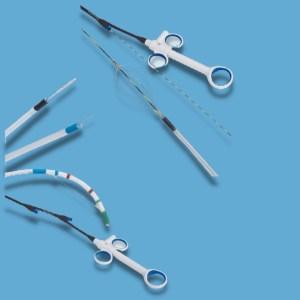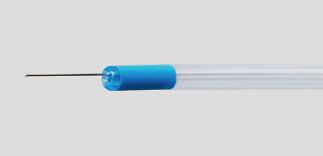ERCP instruments - application in bile duct pathology

Impaired bile flow is a common pathology in surgery. Most often, this condition occurs due to gallstones in the gallbladder and ducts, but in the elderly, jaundice can be associated with the growth of a pancreatic tumor.
Previously, the surgical intervention was performed by open access, but now surgeons prefer the method of endoscopic retrograde cholangiopancreatography.ERCP is the insertion of a flexible endoscope into the duodenum, examination of the fascicle, bile, pancreatic ducts and retrograde (against the flow of bile) contrasting of these structures. ERCP instruments allow the examination to be performed safely for the patient.
ERCP can be complemented by lithotripsy (when stones are too large and get stuck in the duct), stenting of the duct (when the tumor grows to restore the outflow of bile), and biopsy of the tumor when the diagnosis is not established.
Основні інструменти для endoscopic retrograde cholangiopancreatography:
- Sphincterotome. It is used to dissect the sphincter and cannulate the ducts.
- Papillotome. This tool is used to cut the papillae fascia when it is impossible to introduce instruments. Sometimes an air balloon is used instead of a papillotome.
- Stone retrieval basket. Вони мають різну форму для надійного видалення каменів та атравматичний наконечник, щоб не пошкодити інші органи.
ERCP procedure instruments are made of different materials, but all of them have anti-corrosion properties, are not damaged by stomach acid and mechanical movements (subject to the operating rules).
Ендоскопічні інструменти для ерхп Alton Medical можна суміщати з сучасними гастродуоденоскопами, враховуючи індивідуальні параметри.
Disposable ERCP accessories - what are the benefits?
Single use ERCP instruments (sphincterotomes, papillotomes, ERCP baskets) cannot be reused. But this gives them certain advantages:

- They fully retain their properties during the procedure, and there is no risk of mechanical wear of the equipment.
- No lengthy processing is required (mechanical cleaning with scope cleaning brush, soaking in a disinfectant solution and sterilization with high-temperature steam).
Some of the additional tools for ERCP instruments (for example, biopsy forceps) have a complex surface of the working part, which is difficult to clean even during machining.
Also disposable instruments used for ERCP – is one of the factors that influence a patient's decision to be treated in a particular medical facility. The use of reusable equipment for any endoscopic procedure always carries a risk (albeit minimal) of cross-infection with dangerous diseases. The equipment in sterile packaging reassures the patient and builds trust in the doctor and the facility. Disposal after examination and treatment eliminates the possibility of reusing the instruments.
